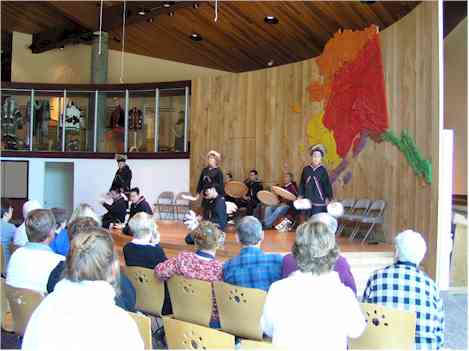
Kenai Peninsula
The Kenai Peninsula lies in south central Alaska with Anchorage (the largest city in Alaska) at the north end and with Homer and Seward in the south.
Anchorage is a small to medium sized city much like any city in the "lower 48" and was of interest in only two aspects; Best Buy and the Alaska Native Heritage Center. Best Buy was important because our GPS had quit working while we were in Canada and the Canadian Best Buy stores would not honor the warranty. Best Buy corporate support services told us there were no stores in Alaska. We found one in Anchorage by accident. It had been open for over a year. This good luck was somewhat dubious however since the Alaskan and Canadian maps are so bad. The GPS seldom showed us within 200 feet of the road we were driving on. There was a warning on the GPS box that said the data was from "unconfirmed government sources" and we all know just how accurate government sources are.
The Native Heritage Center was worth the visit.

These drummers and dancers were from the Yupik tribe. They were high school kids living in Anchorage.

This Yupik totem was also displayed in the Center along with typical dwellings, clothing, tools and crafts. Other local tribes were represented but to a lesser degree. Each display was presented by a member of the tribe represented to explain the objects shown and to answer questions about them. All the the tribal representatives were very personable and knowledgeable.
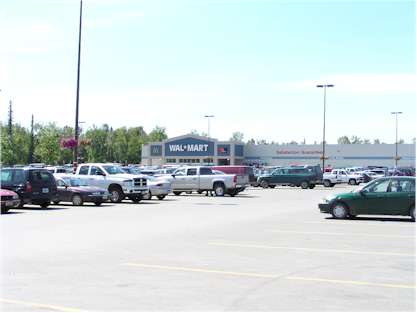
This is the Wal-Mart store in Wasilla, a small town just north of Anchorage. They made the claim of selling more duct tape than any other store in the world during the previous year. Along with all the uses usually stated for duct tape there was a new one on me. It was apparently used to protect the faces of dogsled racers ("mushers") from the extreme cold. I can only hope that they remembered to shave closely before applying the tape.

This is a view typical of central Alaska piney woods. It is unusual in the view of Mount McKinley completely free of clouds. Two other snow-covered peaks of the Alaska Range are also visible.
 This is a view of the fjord
along the Kenai taken from a lay-by along side the highway. We spent the
night here on the way to Seward. A great many of these lay-bys have been
built along all of Alaska's highways and overnight camping is allowed in all of
them.
This is a view of the fjord
along the Kenai taken from a lay-by along side the highway. We spent the
night here on the way to Seward. A great many of these lay-bys have been
built along all of Alaska's highways and overnight camping is allowed in all of
them.
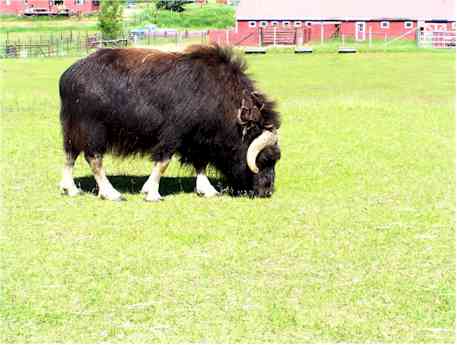
This picture was taken on a musk ox farm near Palmer. The name of this animal is a misnomer since it does not exude musk nor is it even related to an ox. Somehow though, the the name seems appropriate. It just looks like something that should be called a musk ox. They had actually become extinct is Alaska until a number of animals were imported from Canada and Siberia. They are now doing well.
The musk ox has 2 layers of hair. The inner layer is very soft and fine and is shed each spring. At this farm the inner hair is collected and is spun into a very fine, soft yarn. It is softer than angora. The natives in the area knit the yarn into hats, gloves, scarves, etc. These are very warm and also very pricey. One pair of mittens was selling for around $100.
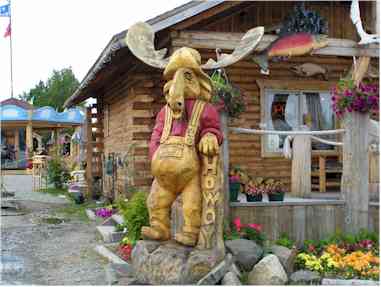
Along the highway we saw a place displaying wood carvings. The subject were wide ranging from this somewhat irreverent moose to religious scenes. The rough carvings were done with a chain saw and then finished by hand. There was even a complete, working carousel with Alaskan animals. The prices of the items were not cheap but the looking was free.
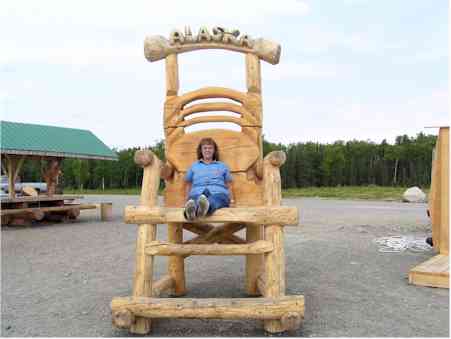
Everything in Alaska is huge, even the furniture. Here is Marilee checking out the comfort of a kitchen chair.

Even the fish are huge; or at least the fish tales are.

The influence of the early Russian settlers can still be seen in many places, particularly in southern Alaska. This is the Russian Orthodox Church, Holy Assumption of the Virgin Mary in the small town of Kenai in south central Alaska. It was built in 1894 and still holds regular services. The priest was very interesting to talk to. He told us a great deal about the history of this particular church and about the Russian Orthodox Church in general. He made a special point of the fact that his church had not broken away from the Roman Catholics but that it was indeed the other way around.

This is the Step Glacier near Seward. It is fed from an ice field that covers more than 4000 square miles. This glacier is in general retreat; an average of about 50 feet per year.

This is a closer view. The people you see in the foreground had to wade through knee-deep, icy water to get there. You will not see me in the picture.
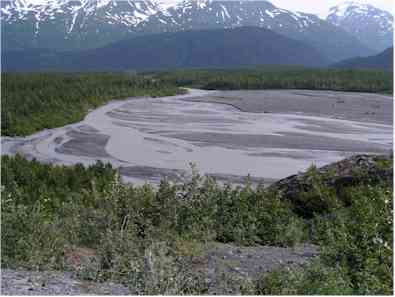
The melt water from the glacier forms a respectable river.
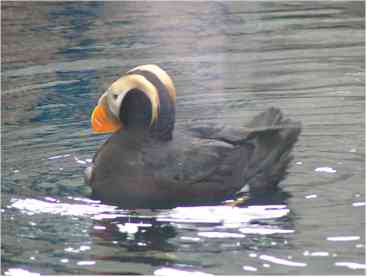
This funny looking bird is called a puffin. It looks like a cross between a duck, a parrot, and a goat. It has the body of a duck, the bill of a parrot and what looks like the horns of a goat on its head.